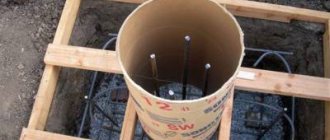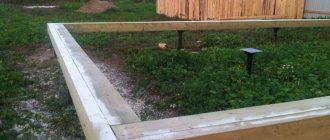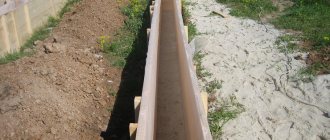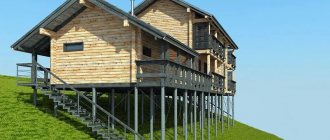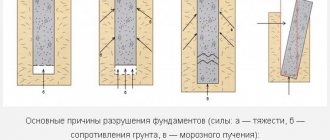The service life of many building materials, especially wood, is significantly reduced in conditions of high humidity. In residential buildings, the floor of the first floor is in direct contact with the basement, where it is damp and cold all year round. In this regard, many customers ask the question: is it necessary to make vents in the foundation of a wooden house?
Vents in the foundation Source aireng.ru
What will the lack of air lead to?
Vents, or vents, are through openings (holes) located above the surface of the ground in the foundation, in the walls of the basement or on the floor of the basement. Openings made in accordance with building codes provide sufficient air ventilation, resulting in evaporation and release of moisture to the street.
The lack of ventilation in the foundation leads to the following:
- Accumulation of large amounts of condensation, 100% humidity.
- Condensation settles on wooden beams, ceilings, and boards of the rough floor structure.
- Fungi, mold and other living microorganisms actively reproduce.
The result is rotting and destruction of materials.
Rotting as a result of moisture accumulation Source chng.kf.ru.net
Due to the above, you should never close the vents, including during the cold season. But to reduce heat loss, the floor should be properly insulated.
Which ventilation scheme should I choose?
So, we have figured out whether an underfloor ventilation system is needed, and now it remains to decide which scheme to choose for specific conditions. There are several important points to consider when choosing a system. The operation of ventilation largely depends on the type of climate in a particular area, average street temperature, etc.
When installing natural ventilation, the main rule must be observed: the supply openings are located below the exhaust openings. The greater the altitude distance between them, the more efficient the system is.
Natural ventilation is more effective in winter, since it is at this time that a large difference is recorded between the temperature inside the underground and outside, which ensures good circulation of air masses.
However, with an even greater drop in temperature, there is a possibility of an excessive increase in air exchange, which is also not particularly good, as it can lead to freezing of structures. Therefore, if the temperature drops significantly, the vents must be closed.
If the house has supply and exhaust ventilation, it makes sense to connect the exhaust from the basement to the general circuit. This way, the outflow of air will be stimulated in any weather.
To install a combined ventilation system for a small underground area, it will be enough to install one pipe. In order for it to provide both output and reception of air masses, it needs to be divided vertically into 2 channels.
Such ventilation pipes are sold in hardware stores. Each channel has its own valve to adjust the flow intensity. The functioning of such ventilation is checked quite simply: you need to attach a sheet of paper to the outlet holes one by one.
Video description
The need for vents and the intricacies of their design are described in more detail in this video:
Radon
Another serious reason to vent is the accumulation of radon gas in an unventilated basement, which, sometimes very actively, is released from the soil. If the gas has nowhere to go, it begins to leak through micro-cracks into the living space.
Radon is a natural gas characterized by radioactivity and is dangerous to human health.
See also: Catalog of companies that specialize in foundation repair and design.
Calculation of ventilation vents
Based on building codes, during the construction of the foundation, calculations are carried out that allow the vents to be correctly positioned. You can use the following example as a guide.
If the basement area is 100 square meters, then the area of the vents is 0.25 m2. On each side you can install 4 holes, the area of each of which will be 0.03 m2, or 300 centimeters. Thus, you can make rectangular vents measuring 15x20 cm.
When calculating, you also need to take into account the region in which the house is being built. If there is seismic activity in the area, then the size of the vents should be 1/100 or 1/150 of the basement floor. That is, in a house with an area of 100 m2, ventilation will occupy 1 m2. Each of the 8 holes can occupy 0.12 m2.
Reasons for high humidity in the presence of vents
There are quite a few known cases where vents were made in the foundation, but the humidity in the underground remained at an unacceptably high level. This can happen for the following reasons:
- The equilibrium relationship between temperature and humidity is disrupted. In the summer, a large amount of warm air flows through the vents into the cold room under the floor. The temperature difference contributes to the process of air condensation and the appearance of water droplets on the inner walls of the foundation. The accumulation of moisture is explained by the insufficient total area of the existing vents; as a result, all the moisture does not have time to evaporate.
- Increased evaporation of water from the soil under the foundation, abundant groundwater passing high, close to the surface of the earth. A lot of moisture also enters the subfloor, which does not disappear.
- Water flowing underground during heavy rains or when snow melts.
Water leakage is one of the reasons for high humidity Source aireng.ru
High humidity can be avoided if the ventilation holes are properly organized.
Subtleties of proper operation
It should be remembered that the movement of dry air eliminates condensation. High-quality ventilation is possible with proper operation of the ventilation system.
It is necessary to constantly monitor the weather conditions and carry out simple measures:
- Close the air dampers during long rains and melting snow in the spring.
- Regularly treat the inner surface of the foundation with lime or special antifungal impregnations;
- To combat excess moisture, you can use boxes with sawdust, sand, and salt, periodically replacing the filler with dry ones.
The basement should be ventilated in the dry summer heat, and in winter leave small gaps in closed sinuses for draft.
In winter, it is imperative to clear the snow from the walls around the entire perimeter of the house so that when the spring melts, water does not flood the foundation.
Even if the foundation of the house is protected by an effective wall drainage system, regular snow removal is required. During frosty periods and heavy rainfall, ventilation vents should not be covered with snowdrifts.
Organization rules
A sufficient number of vents of a certain area, especially in combination with an exhaust riser, guarantees optimal air movement, which prevents premature destruction of wooden structures, in this case the floor.
First of all, it is necessary to perform the calculations correctly.
Vent location diagram Source nashdim.org
Quantity
The number of vents is determined per unit volume of the basement according to SNiP 01/31/2003. According to this document, in a basement of 400 m3 it is necessary to create at least one opening for ventilation. In areas characterized by a climate with high humidity, form air in the amount of 1 pc. for every 100-150 m3.
There are also vents in the foundation walls; in one inner wall there should be one large through hole, or several, as in the outer walls.
Vents are located both in the outer walls of the foundation and in the piers Source zen.yandex.ru
For better ventilation, vents with access to the street are made not only in the walls, but also in the floor. They must ensure free movement of air and draft.
How to fix the situation
What to do if there is a foundation, but they forgot to make vents or their sizes are insufficient for normal ventilation - fungus, high humidity and other “charms” have begun to multiply in the underground. There are several ways to solve the problem:
- Increase the size of existing ones or drill new ones. Drilling into a monolithic foundation is not an easy task. This can be done either using a crown of a suitable size. If you don’t have a crown, you can take a long, large-diameter drill and use it to drill many small holes around the perimeter of the vent. Then the remaining gaps are drilled, and the uneven surface is then either sanded or simply covered with a grid. Another way is to order diamond drilling. In this case, special equipment is used, holes are drilled much softer, without shock loads.
Diamond drilling in the basement of a building - If it is not possible or desirable to make new or expand old vents, you can improve draft by connecting one or more pipes from the vent to the roof. Due to the pressure difference, the draft will be better and the humidity will decrease.
- Make forced ventilation. To avoid turning it on/off manually, you can set a timer or a differentiated thermometer. It will turn on the fan when the temperature in the underground is higher than outside (a condition for condensation).
- Reduce the amount of moisture entering the subfloor. Most often, the source is soil, especially when the groundwater level is high. It is covered with a vapor barrier. Thick polyethylene film (thickness from 150 microns) is suitable. It is laid so that one sheet overlaps the other by 10-15 cm. The joints are taped with double-sided tape (you can do it twice - at the beginning of the “overlap” and at the end). The film is placed on the walls by 20-30 cm and secured with a strip. To prevent the film from being damaged during further use, a layer of sand is poured over it or a skinny screed 3 cm thick is made. If the foundation, blind area and base are insulated, this gives a good effect - in combination with a ventilation pipe leading to the roof. If there is no insulation, condensation will form on the film. By making a slope in one direction, moisture can be collected and removed outside the subfloor. This option, although worse, works.
- For ventilation of the underground in a bathhouse (heated) or in houses with stove heating, there is another solution - install the stove so that the air is drawn from under the floor (make a vent below the level of the finished floor).
Ventilation of the foundation by taking air into the furnace from the underground - No underground floor - no ventilation needed. To implement this axiom, the entire space from the ground to the subfloor is filled up. The most affordable material with good heat-insulating properties is used. Usually this is expanded clay. Its disadvantage is that it is hygroscopic and is capable of “pulling” water from the ground. If the groundwater level is high, if you do not provide high-quality waterproofing on the ground (film extending onto the walls), things can only get worse. There is a second suitable material with better thermal insulation characteristics and is completely non-hygroscopic - granular foam glass or broken glass. This material appeared relatively recently and few people know about it. For this case - an excellent choice. True, it is more expensive than expanded clay, but it is also many times warmer and safer (expanded clay is often environmentally unsafe).
What you need to know about creating vents in a strip foundation
Vents are created at the stage of foundation construction. The complexity of the work depends on the material from which the strip structure is made. Each option has its own nuances.
Concrete foundation
It is easier to make round vents in a concrete foundation. To form them, plastic or asbestos pipes are used, the diameter of which is determined according to the calculation rules presented above.
A plastic pipe is inserted into the reinforcing frame and fastened together with wire. The main thing is that the resulting assembly units (future vents) are installed in the formwork to pour concrete in the right place and in the required quantity.
Vents in a concrete foundation Source rekvartira.ru
The pipe is first filled with sand, which protects it from breakage. After the concrete solution has hardened, the sand is removed, creating a round through hole in the foundation wall.
Sometimes through openings in concrete are made using wooden blocks, which are installed in the formwork before pouring the mortar. You can't do that! It is very difficult to remove wooden elements after the concrete has hardened. They have to be knocked out using sufficient force, which damages the integrity of the foundation itself.
Brick or block foundation
In such a foundation it is advisable to construct rectangular or square vents.
When organizing openings, it is necessary to use a reinforcement cage. Its rods in the foundation are placed along a horizontal plane, in this case it serves as a support for the upper parts of the masonry.
Brick vents Source superarch.ru
In a brick foundation, half or part of the brick is used to provide ventilation during installation, resulting in a square or rectangular opening.
Is it difficult to vent a finished foundation?
Sometimes situations arise when ventilation was not done at the stage of building the foundation. In this case, it is formed into a ready-made structure.
The main difficulty of the issue is the availability of specialized tools, because to create a hole you will need diamond drilling. If the necessary tool is not available, and its cost is quite high, it is better to turn to professionals - this will not only save on the purchase, but also ensure better quality work.
Hole shape
Ventilation holes installed in the foundation can have a round, triangular, or square cross-section - the choice is yours. Just remember that their area must be sufficient to effectively remove moisture from the basement.
So, we have determined the number of vents required for installation in the strip foundation of our building. Now, in accordance with the construction rules, their minimum area should be clarified, which should not be less than 0.05 square meters. m. Translating everything into the usual dimensional parameters, we find that the size of the rectangular ventilation hole of the strip foundation should be at least 250 by 200 cm or 500 by 100 mm, and for round holes a diameter of twenty-five centimeters is selected.
For multi-story buildings, such holes are quite suitable, but in a private house or in the foundation of a bathhouse they will look too large. As a rule, their size is reduced by half, but the number is increased in order to maintain the total number of vents for the entire available cubic capacity.
How to close the vents
Through openings should be covered not with blind, but with air-permeable grilles. Plugs are required to be installed; they protect the underground from the penetration of rodents, cats, birds and other animals.
Plastic ventilation grille Source roomester.ru
There are many different types on sale that are mounted on a street hole:
- large openings are covered with bars made of steel reinforcement with corners or metal mesh, including stainless steel;
- plastic products differ in shape (including in the form of an outlet at an angle of 90), sizes, and have an aesthetic appearance;
- In the workshops, gratings are made to individual orders.
When choosing a product, you need to pay attention to the presence of a check valve. For foundation ventilation, the valve is an unnecessary element (it must always be open, and this will have to be monitored). You should choose options without it.
Grilles with decorative design Source luxury-kamin.ru
Plastic windows
Today, such options are used much more often; they have also begun to be installed in bathhouses.
Advantages of plastic frames
When the window frame is made of PVC, it has its advantages:
- it is completely sealed and does not allow sounds to pass through;
- does not absorb moisture, so it will not swell over time;
- will last for many years;
- does not require special care;
- is resistant to temperature fluctuations;
- can be opened to ventilate the room.
If we are talking about a bathhouse, then it is recommended to install double-glazed windows. With their help, you can guarantee complete thermal insulation and tightness. Thanks to such windows, a stable microclimate is created indoors. Even if it is very cold outside.
When venting is not necessary
Conditions have been identified whose presence makes it possible to do without vents:
- the inside of the foundation is filled with sand, while a concrete slab is installed on the foundation walls;
- the soil under the house is covered with a vapor barrier film, which does not allow moisture to penetrate inside;
- the underground is equipped with an independent, high-performance ventilation system, the foundation and basement are well insulated;
- the underground floor is directly connected to the heated room (additional space is created for storing items).
The question often arises: are vents needed in a foundation without a basement? If at least one of the first three points is fulfilled, there is no need for vents. In other situations, vents are required.
Why ventilate the underground?
ventilated underground
Natural ventilation occurs through vents, that is, excess moisture is removed. The latter usually appears from the ground. There are two reasons:
- High location of groundwater.
- If there is flooding in the basement. The reason is precipitation or water from melted snow.
High humidity negatively affects the building materials that were used in the construction of the foundation and floor of the house. They lose their technical characteristics, and, accordingly, their operational life. Simply put, they begin to rot, crack, and collapse.
There is another reason to organize foundation ventilation. This is a gas called radon. It is often found in the ground at many construction sites. The gas is radioactive and quickly penetrates into the rooms of the house, harming human health. You definitely need to get rid of it, and perfumes help a lot with this.
Features of work
You should also observe the main nuances when carrying out construction work:
- After installation is complete, you need to install the grates on the vents in the foundation. This will serve as a barrier to small rodents entering the building.
- Typically, construction work is carried out at the time of installation of the foundation. If for some reason the work was not completed, it is necessary to install air ducts using special equipment on a finished foundation. A diamond drill is suitable as a tool. It is able to cope with any loads and overcome obstacles in the form of reinforcing bars.
- It is necessary to accurately select the drill size. It must correspond to the calculated hole diameter. When working with a diamond drill, the strength of the walls is maintained, the edges do not crumble, and the level of reliability is maintained.


